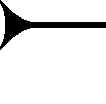Mi (cuneiform)
The cuneiform mi, (also mé) sign is a distinctive sign in the wedge-stroke

Sign mi, 4th sign, line 10.
(high resolution, expandible photo)
| Wikimedia Commons has media related to Mi (cuneiform). |

The sign can be found in the Epic of Gilgamesh and the mid-14th century BC Amarna letters. The signs usage in the Epic is as follows: mé-(1 time), mi-(126), MI-(9).[4]
Partial list of signs beginning with wedge (u)
Partial list of signs beginning with (wedge)-u, from the Epic of Gilgamesh (Parpola, 1971), and the Amarna letters:
- Cuneiform-u--Sign No. 1---
- Cuneiform-AMAR, ṣur, zur--Sign No. 2---

- Cuneiform-di--Sign No. 3---
- Cuneiform-ki--Sign No. 4---
- Cuneiform-mi--Sign No. 5---

- Cuneiform-ši, lim, or IGI ("in 'face' of", "before" Sumerogram)--Sign No. 6---
- Cuneiform-u--Sign No. u-1---
- Cuneiform-ú--Sign No. u-2---

- Cuneiform-Ù-(u-3)--Sign No. 7---
- (With an added horizontal,

- (With an added horizontal,
Also:
- Cuneiform-ar, (Shuwardata of Amarna letter EA 282)
- Cuneiform-nim-(nem, nim, num, and Sumerograms NIM, NUM) (EA 34)
References
- Moran, William L. 1987, 1992. The Amarna Letters. EA 365, Justified War, p. 362.
- Parpola, 197l. The Standard Babylonian Epic of Gilgamesh, Glossary, pp. 119-145, mūšu, p. 133.
- Parpola, 197l. The Standard Babylonian Epic of Gilgamesh, Glossary, pp. 119-145, mūšu, p. 133.
- Parpola, 197l. The Standard Babylonian Epic of Gilgamesh, Sign List, pp. 155-165, no. 427, p. 163.
- Moran, William L. 1987, 1992. The Amarna Letters. Johns Hopkins University Press, 1987, 1992. 393 pages.(softcover, ISBN 0-8018-6715-0)
- Parpola, 197l. The Standard Babylonian Epic of Gilgamesh, Parpola, Simo, Neo-Assyrian Text Corpus Project, c 1997, Tablet I thru Tablet XII, Index of Names, Sign List, and Glossary-(pp. 119–145), 165 pages.
|
|
